|
COVER STORY | IN
THE NEWS | STAGE
MATTERS | ARTBEAT August 17, 2006
Above: Solar array for power plant at HSU's IF YOU BELIEVE IN THE AWESOME POTENTIAL OF HYDROGEN ENERGY, then talking to Peter Lehman can be a real turn-off. If authors like Jeremy Rifkin, who wrote The Hydrogen Economy, have convinced you that hydrogen will one day rocket the planet to a new era of abundant, clean energy, Lehman will point out that hydrogen is a very expensive way to store energy, not an energy source at all.
Such opinions may seem odd coming from Lehman, who sits on the board of the National Hydrogen Association, and who directs the Schatz Energy Research Center at Humboldt State University which produced both the first street-legal hydrogen fuel cell vehicle and the first solar-powered hydrogen energy system in the United States. Right: Peter Lehman. Photo by Bob Doran. As Lehman sees it, however, the myths about hydrogen energy are big distractions from the real energy challenges facing the planet, America in particular. "The biggest misconception people have is that hydrogen energy technology is a silver bullet technology that will save our butts and enable us to have business as usual and not have to deal with dwindling energy supplies and global climate change," Lehman said recently. It's not that Lehman isn't excited about technology. In fact, he's amped up about things like solar hot water heaters and electric vehicles, cogeneration that can efficiently produce heat and power on-site for a building or a school, energy-saving appliances and super-insulated homes. He even approves of the high-tech natural gas engines that are slated to replace Pacific Gas & Electric's aging steam turbines at the Humboldt Bay Power Plant. "They're incredibly efficient," he said of the Finnish-made engines, "as efficient as any fuel cell." So why even bother with hydrogen and fuel cells? Because, according to Lehman and his colleagues, at some point in the future — perhaps 20, 30 or 40 years from now — conventional energy sources will be so scarce that humankind will have to rely mostly on renewable energy sources like wind and solar. In that scenario, hydrogen technology will be critically important for storing and transporting energy. The Schatz lab's focus on hydrogen was also a natural progression of Lehman's pioneering career in alternative energy. And it was the product of a remarkable connection that Lehman and his co-director, Charles Chamberlin, established 17 years ago with a taciturn and wealthy plastics manufacturer who happened to be interested in hydrogen energy. Harvesting the sun Like many Americans of his generation, Lehman, 61, got engaged in solving environmental problems during the late 1960s. He was a graduate student in physical chemistry at the University of Chicago during the first Earth Day, April 22, 1970, when he volunteered to speak at local high schools about Chicago's severe air pollution. Originally headed for an abstract research career, he began charting a course that focused on tangible environmental issues. Along the way, he had some singular experiences that formed his passion for renewable energy, one of which was in a place called Deep Springs. "Did you ever hear of Deep Springs College?" he asked me one day as we talked over lunch at Arcata's Golden Harvest restaurant. I hadn't. "It's an interesting place, a whole story in and of itself," Lehman said. "It's one of the most exclusive, if not the most exclusive, colleges in the world. It's in a high desert valley in Eastern California, and it has 24 students, all men, who live and work on a cattle ranch." The students don't work to pay off tuition but to build character and foster self-reliance, according to Lehman and the college's website. Lehman was hired by the school in 1976 to teach math and science, and he soon realized that Deep Springs was a place made to order for solar energy. For one thing, the high desert climate had year-round sunshine. For another, the students ran a small dairy, and the hot water needed for cleaning and sanitizing equipment was heated with propane trucked from Bishop, 40 miles away. Lehman decided that a solar water heater would be his science class's fall project. Expertise in solar energy was very rare at the time. On a summer trip to the East Coast before starting his job, Lehman went to a large bookstore in New York City and "bought every book they had on solar energy, which was six," he recalled with a chuckle. During the school year, he and a handful of students designed and built a solar water heater from scratch. When they were done, the system worked great, cutting down on the dairy's propane needs significantly. Next, they built a passive-solar greenhouse that grew food and heated an attached classroom building. Concerns about energy were running hot in the United States at that time, with shortage of natural gas and gasoline, and President Jimmy Carter calling on Americans to conserve. After harvesting the sun at Deep Springs, Lehman had a fire in his belly to teach more people about what solar energy could do. 'There might be a job here' The next summer, Lehman and his family visited Humboldt County, where they hoped to relocate. Lehman called HSU from a campground at Richardson Grove, offering to teach a summer class in solar energy. He was directed to Bob Gearheart, then head of the Environmental Resources Engineering program, who asked him to come in for a chat. "I cleaned up as best I could and drove up here. I knocked on Gearheart's door, and we had a great talk," said Lehman. "He listens to my Deep Springs stories, and after a while he says 'there might be a job here for a guy like you.'" Lehman's heart was in his throat. This would be his dream job, but the competition for teaching positions was intense in the late 1970s. He'd recently come in second for a one-year temporary job at California Polytechnic State University, San Luis Obispo, for which there were 400 applicants. Aside from foreseeing stiff competition, Lehman
saw another c "He tells me, 'Well, I'm not an engineer either, I'm a biologist,'" Lehman recalled with a hearty laugh. The position was posted. Lehman applied, interviewed and got the job in the spring of 1979. In the meantime, he'd linked up with HSU students who were trying to start a new experiment in renewable energy and ecological living, the Campus Center for Appropriate Technology. He helped them rehab a decrepit building and taught a hands-on course that produced a solar hot water heater for the structure. Right: Energy in the making: the electrolyzer
splits water "The students who were the early CCAT members and directors worked very hard" on their new home and demonstration center, said Lehman. "They tore off all the sheetrock, they insulated it, they re-plumbed it, they rewired it, put a new roof on, re-did the floors. They worked their tails off. Eventually they built a greenhouse and built the gardens. All that was done by hand." Lehman also credits a few administrators for embracing the CCAT project, which faced resistance from some campus leaders. "It was a radical idea at that time," he said. "[Edward] Buzz Webb, dean of students and vice president, was a real supporter. Don Lawson, the director of physical plant, told me later, 'I don't know why I said yes. I just liked those kids. When they came in to see me, they were nice kids, so I told them, yeah, go ahead.'" In the early 1980s, however, support for renewable energy took a nose dive in the United States. This was due in part to Ronald Reagan's victory over Jimmy Carter, who had supported subsidies for wind and solar power. But there was also a shift in attitudes as the energy shortages of the '70s faded from memory, according to Lehman. "Gas was cheap again [and people thought], 'We don't need to worry about [conservation] anymore.'" But through the 1980s, more and more students coming to HSU were interested in renewable energy, and Lehman's classes were in high demand. He and a colleague, Charles Chamberlin, started doing solar photovoltaic research for CalTrans and other clients. Then Louis Schatz came on the scene. The benefactor Schatz was a retired entrepreneur who had briefly worked in forestry before founding what turned into a successful plastics manufacturing company in 1941. He became interested in hydrogen after helping his sons with a high school experiment. To produce the gas, they used electrolysis to split the hydrogen and oxygen in water, a standard high school chemistry project.
But Lehman didn't know anything about Schatz when he got a phone call one day in 1989 from an HSU administrator who asked him, "'Do we have a hydrogen energy program?' I said, 'No. Why?'" The caller explained that a donor, who had already given the college a tree farm, wanted to fund research on hydrogen and renewable power. This was intriguing to Lehman, who had pondered hydrogen's potential as a storage medium for renewable power. He was familiar with the limitations of battery storage systems used by off-grid rural residents to store solar energy for use when the sun wasn't shining. Something more flexible and powerful would be needed to use renewable power on a larger scale, and hydrogen might be it. Hydrogen could be made with solar or wind energy, then run through a fuel cell or even burned in an internal combustion engine — with no greenhouse gas emissions — to provide power whenever and wherever it was needed. "I thought if we were really going to transition to a renewable energy future, it could be used for energy storage and energy transport," said Lehman. "Because solar and wind energy are intermittent — the sun doesn't always shine and the wind doesn't always blow — you need some way to store energy and you need a way to turn solar and wind energy into a transportation fuel." He offered to send Schatz a proposal, an idea the administrator readily endorsed. A few days after Lehman mailed the proposal, Schatz called him. "He was all business," Lehman remembered. "He didn't say, 'Hi. I'm Mr. Schatz.' It was, 'Hi. You sent me this proposal. I have some questions.'" After the talk, Lehman rewrote the proposal and sent it back to him. "Two weeks later I got a little envelope from him with a check for $75,000," said Lehman. "All of a sudden, we were on." But Lehman and Chamberlin soon ran into an unexpected problem. "I had thought that if you wanted a fuel cell, you called up a company and ordered a fuel cell," Lehman said. "That wasn't true. Very few people made fuel cells. We finally found a company that said they would make one. We sent them a lot of money, and they never sent us a fuel cell that worked." Schatz and Lehman talked on the phone regularly, and the retired businessman soon grew frustrated with the delays and called the laggard supplier himself. "Then he called me up and said, 'Get rid of those guys. They don't know what they're talking about,'" said Lehman. "I said 'OK, but what are we going to do to get a fuel cell?' He said, 'Build your own.'" Lehman recalls feeling daunted, and telling Schatz that they'd need to build an entire lab from scratch. "He said, 'OK, write a proposal.' I sat down and wrote a proposal for $300,000," said Lehman. "A week later I get another envelope. . . . In it was a check for $300,000 — $300,000! — and a scrap of paper with a note on it that said 'Get to work.'" Two years later, they threw the switch on a small power plant that — to this day — runs the compressors at HSU's Telonicher Marine Lab aquarium in Trinidad. When the sun is out, solar panels produce enough electricity to run the compressor and power an electrolyzer, a refrigerator-sized device that splits water into hydrogen and oxygen. The hydrogen is stored in tanks, and when the sun goes down or is obscured by clouds, a computer sends the hydrogen to a fuel cell that generates electricity, keeping the aquarium compressor working. "When I called Schatz to tell him that it all worked, he said, 'That's great. What are you going to do next?'" With funding from Schatz and other sources like the U.S. Department of Energy, Lehman, Chamberlin and their team of research engineers took on more projects. They refined their original fuel cell design and licensed it to a private company, generating modest royalty income to help support further research.
Schatz died in 2001, just shy of 90 years old. He left an endowment of about $10 million, which yields a permanent stream of funding for the research center. Right: Solar hydrogen schmatic. The world's future Despite all its subsequent accomplishments, the solar-hydrogen power plant in Trinidad may be the Schatz center's most important achievement. Before it was created, all methods of making hydrogen produced emissions of carbon dioxide — the greenhouse gas most responsible for global climate change. Energy experts from around the world have visited the marine lab's power plant, and it has served as a model for similar projects by automakers and others who are experimenting with fuel cell vehicles. Right now, the electricity it produces is wildly expensive, but as the cost of components such as solar panels, electrolyzers and fuel cells come down, the technology will become more economical. Even then it will never produce electricity at anywhere near today's prices. The real value of the system is the window it opens on the future. Even mainstream energy industry leaders acknowledge that power systems like the one at the marine lab will one day produce much of the world's energy. Henry R. Linden, for example, is the former head of the industry lobby group Gas Research Institute and a signer of the Leipzig Declaration, which discounts the severity of global warming. Linden wrote in the Nov. 15, 2002 edition of Public Utilities Fortnightly that while he doesn't accept the "alarmist projections" of global climate change, allowing carbon emissions to continue rising at current rates for the next 100 years is "too risky." By 2100, according to Linden, the world will "need a truly sustainable and essentially carbon-emission-free global energy system." He doesn't mention the Schatz power plant directly, but he writes that solar and wind energy will be "mainstay[s] of a sustainable energy system," with hydrogen used as a storage medium to make electricity available when the sun isn't shining and the wind isn't blowing.
Left: Sen. Mike Thompson visits Lehman in his lab at HSU. Photo courtesy of Schatz Center. The energy establishment and U.S. energy policymakers prioritize exploring for more oil and gas in Alaska and offshore, securing supplies from foreign countries, increasing nuclear power and burning more coal to generate electricity. Coal is still abundant and cheap. Modern pollution controls make it cleaner. And its advocates say that new high-tech methods will remove and bury — or "sequester" — the carbon emissions that now make coal the least climate-friendly fuel. Lehman considers this scenario a fantasy designed to prolong wasteful energy consumption. Carbon sequestration hasn't been tested, he says, and he doubts it will work. "There are some places where it's been used on a relatively small scale, but not the kind of scale we're talking about," said Lehman. "The people who are in favor of it will say, 'Oh yeah, we know how to do it,' but I just don't believe them." Finding more fossil fuels and burning more coal are all part of prolonging what Lehman calls America's "energy adolescence." "We've got to start acting like grownups," he said. "We need to treat energy as the precious commodity that it is. We need to be way more conservative and learn to make do with less. That doesn't mean freezing in the dark. We just have to be much more careful about how we use energy."
Individuals can only do so much, however. "It will take a really coordinated national effort on a grand scale," Lehman said. "The American way of developing our society is going to have to change. Having people drive alone in a 4,000-pound vehicle 50 miles one way to go to work, that's just not going to cut it. We can't afford to do that. We're going to have to develop other energy supplies, too." Right: Lehman and James Lenz, general manager of the Southwest Air Quality Management in Diamond Bar, Calif., taking a ride in the first fuel cell- -powered vehicle (1997). Photo courtesy of Schatz Center. That led to a question I'd been saving up. What about nuclear power, which emits no greenhouse gases? He paused about 15 seconds before answering: "I'm not in favor of nuclear power, but I don't think there's any way we're going to avoid it. Waste disposal is an important issue, but I think that can be technically solved. Proliferation is the most serious challenge — having nuclear material end up in the wrong hands." Because of limited supplies of uranium, only breeder reactors using plutonium will be sustainable over a long period of time, he said. "Plutonium is one of the most poisonous substances we know of. A softball-sized amount of plutonium is enough to make a nuclear weapon." How about biofuels like ethanol and biodiesel from corn, soy and other crops? "We already have trouble feeding the people in the world, and it's not clear to me that we can afford to grow energy," said Lehman. "I think it's better to harvest the sun's energy with solar panels or wind turbines than with crops." There are no easy answers to the energy problems facing America, says Lehman. "It will take a really coordinated national effort on a grand scale, and the only way that's going to happen is if there is political leadership that is pushing us in that direction." Humboldt hydrogen I asked Lehman how he managed to avoid despair, with his acute awareness of both the energy challenges facing the United States and the limitations of potential solutions. "You can get depressed pretty easily thinking about this stuff," he admitted. "But I'm kind of an optimist by nature and my work is work that is at least trying to move in the direction of making things better."
Teachers at Arcata High have used the experiment and raised money to buy their own. Other local high school teachers are asking for it, and Lehman hopes to peddle the concept to a manufacturer that could produce it and sell the gear nationwide at a much lower cost than the Schatz lab can build it. Right: Solar electric power plant at HSU's
But does the emphasis on hydrogen mislead students into thinking the technology will be a short-term solution to energy problems? "We discuss where hydrogen fits in our overall energy picture and where we get energy and how that fits into global climate change," said Lehman. The second project is one that Lehman calls a "real Cinderella story." For a design competition run by the National Hydrogen Association, nine HSU students submitted an experimental proposal to tap methane from the closed Cummings Road garbage landfill, turn it into hydrogen and fuel a small fleet of vehicles. Their proposal won the competition, and then their presentation in Washington, D.C., last year so impressed movers and shakers at the NHA conference that the Schatz center has received more than $50,000 to conduct further studies. "If we're lucky, we don't know for sure, we're going to get our first hydrogen vehicle next year from the California Hydrogen Highway Program," said Lehman. "It will be a Toyota Prius which is configured to run on hydrogen. We'd build a fueling station here on campus, and [HSU President] Rollin Richmond wants to drive it." Preliminary estimates show that the landfill may contain enough gas to fuel several buses and cars for 20 years. Currently, the landfill operators burn the gas escaping from the dump because methane is an extremely potent global warming gas, said Lehman. "But all that energy capability is now being wasted," he marveled. "We'd be capturing it, reforming it to hydrogen. There would still be CO2 released but we'd be using that energy to displace fossil fuel, so there's a net good in doing it. Plus there's a net good in using energy that would otherwise be wasted." Really, really rich As Lehman reflected back on 30 years as an energy researcher, he recounted a story of being approached by a venture capitalist at a hydrogen conference. The man suggested that he would finance a spin-off company to manufacture and sell fuel cells, a venture that would make Lehman "really, really rich." Lehman just shook his head. "I told him I was already really rich. I have a wonderful family, a great home and time to ride my bike, climb mountains and paddle rivers. Plus, I work with passionate, committed people who are trying to do some good in the world." Email Jim Hight at jbhight@sbcglobal.net. COVER STORY | IN
THE NEWS | STAGE
MATTERS | ARTBEAT Comments? Write a letter! © Copyright 2006, North Coast Journal, Inc. |

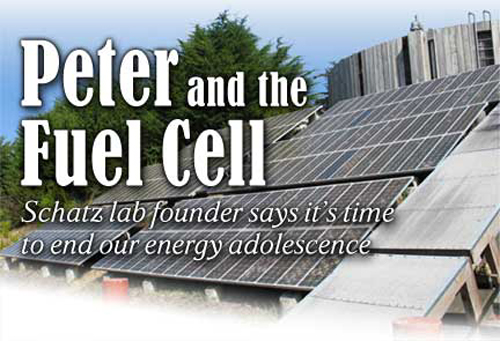
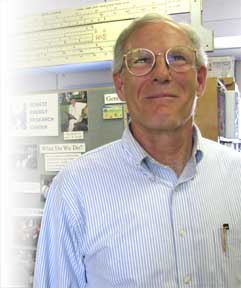 If
you think fuel cell vehicles running on hydrogen will ease up
the accelerator pedal on global warming, Lehman will tell you
that after 10 years of research and development, Honda, General
Motors and other car makers have managed to produce only prototypes
with short life expectancies and million-dollar price tags. He
might add that most hydrogen is made by refining natural gas,
a process that emits carbon dioxide, the culprit of global warming.
If
you think fuel cell vehicles running on hydrogen will ease up
the accelerator pedal on global warming, Lehman will tell you
that after 10 years of research and development, Honda, General
Motors and other car makers have managed to produce only prototypes
with short life expectancies and million-dollar price tags. He
might add that most hydrogen is made by refining natural gas,
a process that emits carbon dioxide, the culprit of global warming.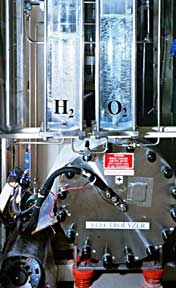 hallenge:
He wasn't an engineer. "I'm thinking 'I've got to tell this
guy the truth.' So I stopped and I said, 'You know, I've got
to tell you something I'd love it if I could get a job here,
but I'm not an engineer, I'm a chemist. I've never taken an engineering
course in my life.'"
hallenge:
He wasn't an engineer. "I'm thinking 'I've got to tell this
guy the truth.' So I stopped and I said, 'You know, I've got
to tell you something I'd love it if I could get a job here,
but I'm not an engineer, I'm a chemist. I've never taken an engineering
course in my life.'" Schatz
later repeated the experiment using electricity from a solar
panel. He put the gas into a balloon, touched a flame to it and
watched it ignite. "He'd turned sunlight into a fuel, and
he was excited about it," explained Lehman. Schatz was also
quite wealthy and wanted to do some good with his money.
Schatz
later repeated the experiment using electricity from a solar
panel. He put the gas into a balloon, touched a flame to it and
watched it ignite. "He'd turned sunlight into a fuel, and
he was excited about it," explained Lehman. Schatz was also
quite wealthy and wanted to do some good with his money.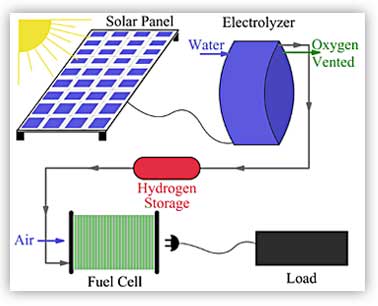 They
built the first street-legal fuel-cell powered vehicle (a golf
cart) and led a consortium of agencies to construct a hydrogen
fueling station for buses in Palm Desert, Calif.. They also built
a remote power system for the Yurok tribe, developed curricula
for high schools and studied the potential of many different
renewable power technologies.
They
built the first street-legal fuel-cell powered vehicle (a golf
cart) and led a consortium of agencies to construct a hydrogen
fueling station for buses in Palm Desert, Calif.. They also built
a remote power system for the Yurok tribe, developed curricula
for high schools and studied the potential of many different
renewable power technologies.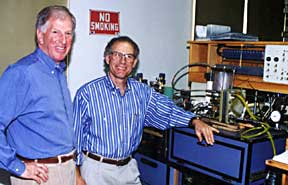 Lehman
would argue with Linden that the planet can't wait until 2100
for renewable energy to become predominant. But his larger disagreement
with such energy industry pundits — and with the majority
in Congress and the Bush Administration, for that matter —
is what should happen now.
Lehman
would argue with Linden that the planet can't wait until 2100
for renewable energy to become predominant. But his larger disagreement
with such energy industry pundits — and with the majority
in Congress and the Bush Administration, for that matter —
is what should happen now.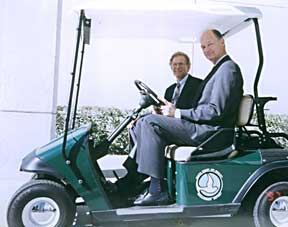 I
asked him what are the most important things that individuals
can do. "Drive less. Buy a fuel-efficient car. Buy energy-efficient
appliances. Turn the thermostat down in the winter and up in
the summer," he said. "If you can afford solar PV [electric
systems] and solar hot water, install those."
I
asked him what are the most important things that individuals
can do. "Drive less. Buy a fuel-efficient car. Buy energy-efficient
appliances. Turn the thermostat down in the winter and up in
the summer," he said. "If you can afford solar PV [electric
systems] and solar hot water, install those."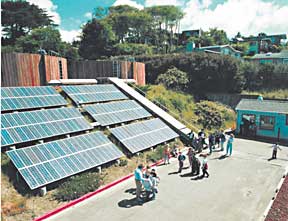 This
led to discussion of two Schatz projects Lehman is particularly
excited about. The first is educational: They've devised a high
school curriculum unit with a small electrolyzer and fuel cell.
"Hydrogen electrolysis and fuel cell technology is a perfect
fit for high school chemistry," said Lehman. "There
are all these concepts which you can illustrate really well with
hydrogen."
This
led to discussion of two Schatz projects Lehman is particularly
excited about. The first is educational: They've devised a high
school curriculum unit with a small electrolyzer and fuel cell.
"Hydrogen electrolysis and fuel cell technology is a perfect
fit for high school chemistry," said Lehman. "There
are all these concepts which you can illustrate really well with
hydrogen."